Pistols That Made the Movies: Famous Clint Eastwood Guns

Whether a casual fan or a full-blown gun nut, there’s nothing better than going to the movies and spotting some of your favorite firearms in action.
Historically accurate? Probably not. Thoroughly awesome? 100%. The choices by those involved to include one firearm or another can honestly make or break a movie, and in some cases, can lead to increased, widespread interest in a specific gun.
Clint Eastwood is a prime example of an actor whose classic movies have made an impact on gun culture as a whole. Starting with his first major role in CBS’s hour-long cowboy series Rawhide, he set the tone of his work to come – macho men defined by their stoicism and missions that can only be solved with lead.
Clint Eastwood guns have shaped today’s firearm market and set the standard of cool for many generations. Here is a breakdown of five of his most notable movies, and most importantly, the weapons that defined them.
Colt 1851 – The Good, the Bad, and the Ugly (1966)
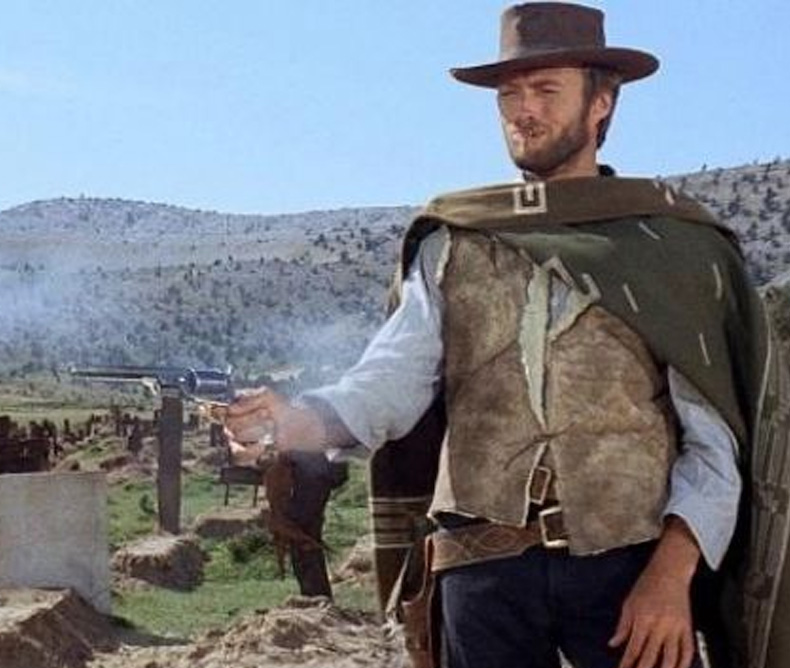
“You see, in this world there's two kinds of people, my friend: Those with loaded guns and those who dig. You dig.”
Queue the dusty lonesome whistling theme song. The Good, the Bad, and the Ugly shot Clint Eastwood to international stardom and informed American culture about how cool it is to remain silent and let the guns do the talking. The final movie in what is now referred to as “The Man With No Name” series follows three bounty hunters as they traverse across a Civil War-era desert landscape in search of gold.
Throughout the movie, there is a wide array of weapons in use that would be considered interesting to a gun lover, but at the culminating cemetery duel, it’s Clint Eastwood’s revolver, the Colt 1851 Navy, that really shows its prowess by putting his adversary in his grave – literally.
Though Sergio Leone, the movie’s director, had an eye for aesthetics when it comes to historical accuracy, the Colt 1851 has a major historical inaccuracy. During the setting of the movie, the revolver remained a simple ball and cap six-shooter, but to meet the demands of high-speed action, Eastwood’s gun features the Richard’s Conversion allowing it to take cartridges for faster reloads, which didn’t become common until 1871.
.44 Magnum Model 29 – Dirty Harry (1971)
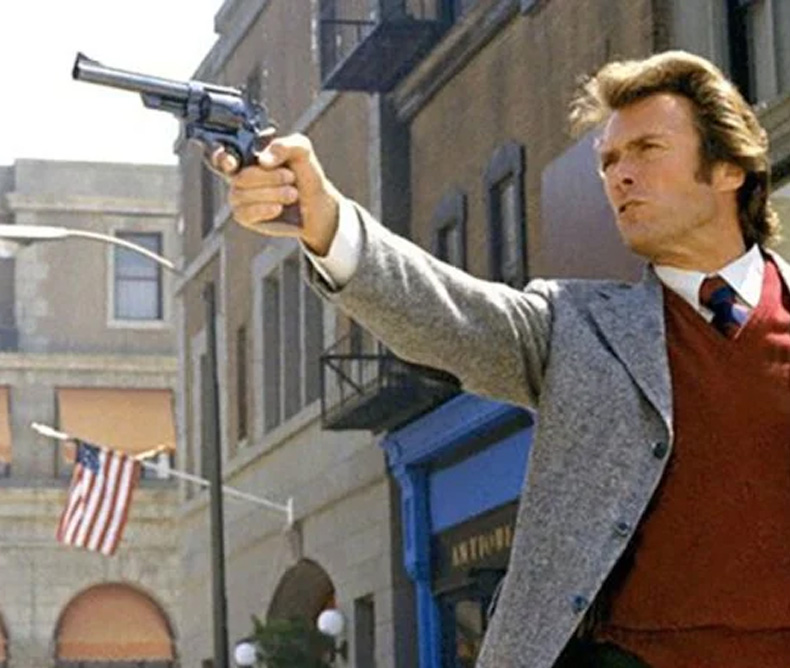
“I know what you're thinking. ‘Did he fire six shots or only five?’ Well to tell you the truth, in all this excitement I kinda lost track myself.”
Dirty Harry is the exemplification of Clint Eastwood as an antihero – driven to good but through completely destructive and immoral means. The movie follows San Francisco Police Inspector Harry Callaghan as he spearheads the hunt for a serial killer while grappling with a department and world that is turning away from Harry’s old-world means of justice.
Eastwood’s character is so unbelievably ruthless that it is easy to see why he makes the choice of sidearm he does. The 6.5-inch blued .44 Magnum, now commonly known as the “dirty Harry gun,” is an absolute cannon in the hands of the 6-foot 4-inch Clint Eastwood. Originally meant for protection against big game, Harry uses it to hunt the most dangerous game of all – a madman on the loose.
Before the movie, Smith & Wesson thought of this firearm as a specialty for those who lived in remote places. But once audiences saw the weapon on the big screen, its identity totally changed to the quintessential badass pistol. Many sought out this classic Clint Eastwood gun to try to get a feel for what it’s like to be dirty. What many figured out after shooting three shots out of the .44 is that being dirty is really hard on the wrists.
Walker Colt 1847 – The Outlaw Josey Wales (1976)
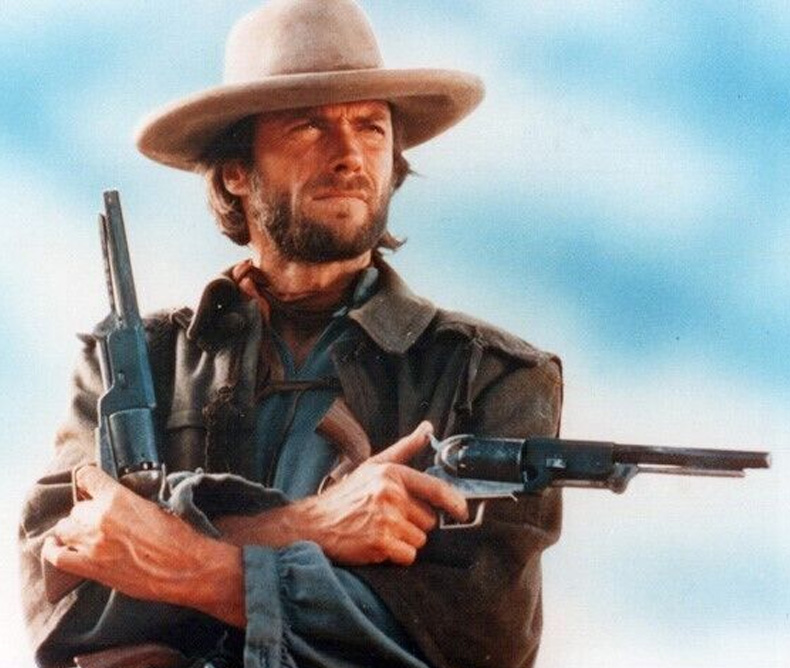
“Are you gonna pull those pistols or whistle Dixie?”
Driven to revenge by the death of his family at the hands of Union Soldiers, the once simple and peaceful Josey Wales shoots his way across the American South and Texas without abandon. Clint Eastwood’s fifth directorial role and second when it comes to Westerns, The Outlaw Josey Wales stands as a fan favorite and works to feature complex character development rather than straight bravado.
Despite the more highbrow themes of the movie, Josey Wales still put his enemies down in style, this time using dual Walker Colt 1847s. In contrast to other roles, Eastwood plays a protagonist with a clear understanding of justice, regardless of what involvement the character had in the Civil War.
Unlike the Colt 1851 previously talked about, the Walker Colt 1847 is completely accurate to the time period. Following the Patterson revolver, which put Colt on the brink of going out of business, there was a major need for higher calibers and weapon consistency. First introduced in the Mexican-American War, the 1847 found its spotlight during the Civil War, saved Colt’s business, and produced grim outcomes for the bad guys in The Outlaw Josey Wales.
Sig Sauer P228 – In the Line of Fire (1993)
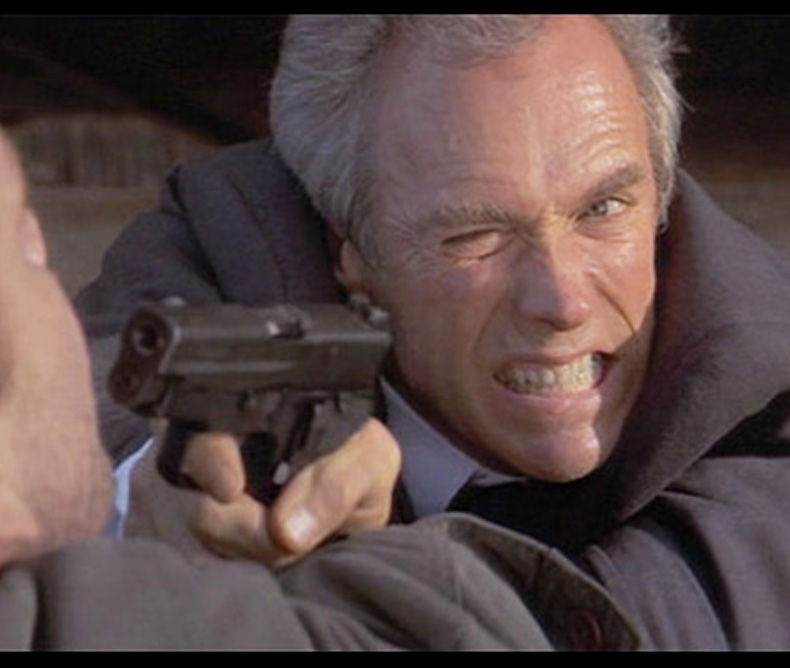
“The world can be a cruel place to an honest man.”
Following up on a complaint about a missing tenant, Clint Eastwood’s character, Frank Horigan, is thrust into his past and reminded of his failures on the day JFK was assassinated. In the Line of Fire is distinctly different from Eastwood’s original box office successes, but is still completely action-packed as a Clint Eastwood movie should be.
As Corrigan tracks down a rogue CIA assassin on a mission to kill the president, an updated arsenal of firearms is displayed that aren’t the standard Clint Eastwood guns in movies. The Sig Sauer P228 serves as an up-to-date sidearm for the character as well as an informed weapon placement by the movie’s creators.
Clint Eastwood movies usually feature overpowered firearms or flashy revolvers, but In the Line of Fire shows a real-life depiction of what someone in law enforcement would carry. The Sig Sauer P228 is known as a “fed gun” and is used by your police on the street all the way up to Secret Service agents protecting the President.
Browning M1911 – Gran Torino (2008)
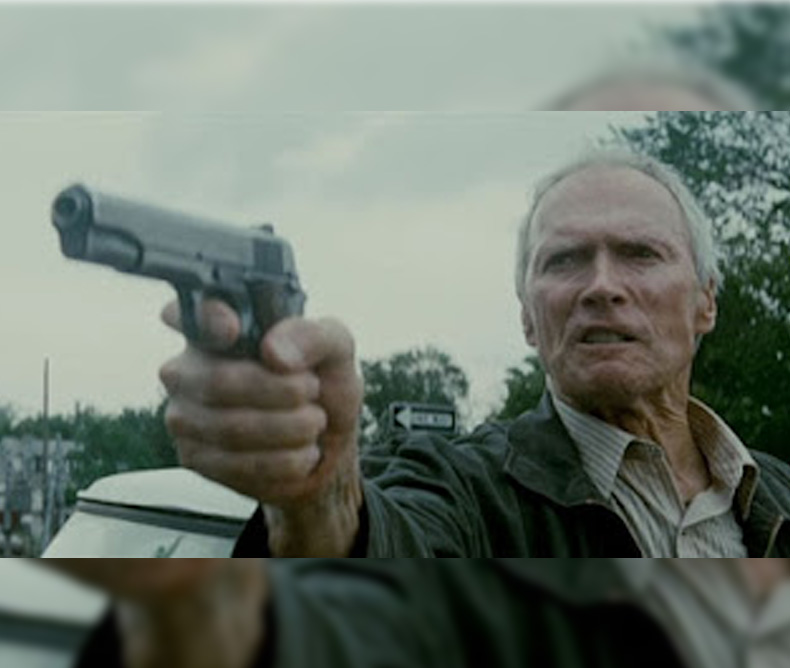
“I’ll blow a hole in your face, then go inside and sleep like a baby.”
Struggling with the changes he sees in his neighborhood, Clint Eastwood’s character in Gran Torino, the Korean War veteran Walt Kowalski, forms an attachment with his Hmong neighbors after saving their children from the rough Detroit gang life. Jaded and crotchety, Walt serves as the enforcement of justice for all despite being confined by a slight sense of bigotry.
Considered for a time “the world’s most respected handgun,” it only makes sense that the Browning M1911 becomes the choice for Walt since he most likely used it in the service. A more representative choice for a Clint Eastwood gun, the M1911 seems to exhibit a return to purpose and attitude for Walt. It's almost like a readaptation of the brutality needed for the battles of Korea but now against hoods and gangbangers.
First introduced during the hunt for Pancho Villa in 1916, there was a need for new technology that gave the U.S. government the upper hand during conflicts. Though the smallest of arms produced at the time, the M1911 proved to be one of the best, having a service run that lasted until the 1980s and bringing true stopping power to the civilian market that is honestly displayed by Gran Torino.
Clint Eastwood Revolvers and Pistols: Honorable Mentions
AMP AutoMag Model 180 – Sudden Impact (1983)
“Go ahead, make my day.” Chambered in .44 AMP, this is another hand cannon from the Dirty Harry franchise. With the futuristic makeup of the gun, It's easy to see why this one was chosen for the first 1980s movie in the series. It’s also easy to see why the original manufacturer of the firearm, Auto Mag Corporation, was only in business for two years.
Smith & Wesson 4506 – The Rookie (1990)
“Sarah, if I die and go to hell, it'll look like my parents' house.” Another larger-than-life Clint Eastwood gun, the S&W 4506 is definitely worthy of this buddy cop movie. If you’re going to teach Charlie Sheen to be a cop, the gun has better be big. The third generation of the S&W 4500 series, this weapon is chambered in .45 ACP and suited to take on the smart and over-the-top criminals of every 1990s action thriller.
Walther PP – Firefox (1982)
Clint Eastwood versus the USSR? I guess that’s a good movie concept to make some money during the Cold War. Sporting the quintessential spy gun, Eastwood is on a mission to steal some science fiction-like plane from Russia to save democracy and eliminate foreign threats. I guess after playing a cowboy for the first two decades of my career, I’d want to play James Bond too.
Summary
Clint Eastwood guns are some of the most iconic in Hollywood history. From the Colt 1851 in The Good, the Bad, and the Ugly to the Browning M1911 in Gran Torino, the firearms featured in his movies always leave an impression – both on the screen and beyond.
If you’re looking for a new IWB, OWB, or pocket carry holster for one of these classic guns or another, head to our Holsters by Gun Model page for Kydex holsters that are custom-made for your weapon of choice.
Interested in items beyond holsters? Take a look at our Resources Page for links to recommended products like lights, lasers, first aid, maintenance, and more. Or, browse our selection of apparel, gun belts, and accessories. And be sure to visit our sister company, GeoGrit, to view our collection of durable, RFID-blocking minimalist wallets.
To stay up-to-date on all the latest Vedder Holsters content and offerings, follow us on Facebook, Instagram, Twitter, YouTube, and TikTok. For more shooting and concealed carry resources, check out our blog or download our FREE e-book “The Concealed Carry Blueprint.” To discover which states honor your carry permit or to learn about CCW laws across the U.S., explore our interactive Reciprocity Map.

